
views
Planting Kalanchoe
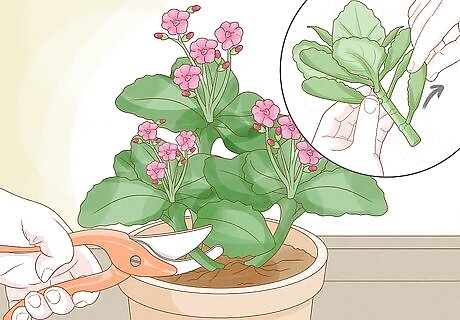
Make a root cutting from an existing plant. The best way to grow a kalanchoe plant is to take a cutting from a fully grown plant, then and planting the cutting to grow a new kalanchoe. Use a sharp pair of gardening shears to snip off a branch of a fully grown kalanchoe branch. Remove all the leaves on the lower 2 inches (5.08 cm) of the branch except for 2 leaves.

Let the cutting dry for 3 days. After you make the cutting and remove most of the leaves, place the cutting on a paper towel and leave it out for a few days to dry. This process of drying the cutting is called “callusing.”
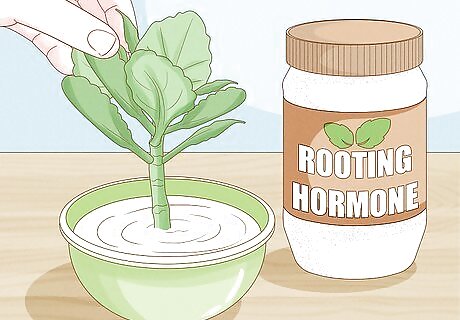
Dip the end of the cutting in rooting hormone. Once the cutting has dried, dip the end that you cut in rooting hormone. Rooting hormone stimulates the cutting so that the roots develop more quickly and healthily.
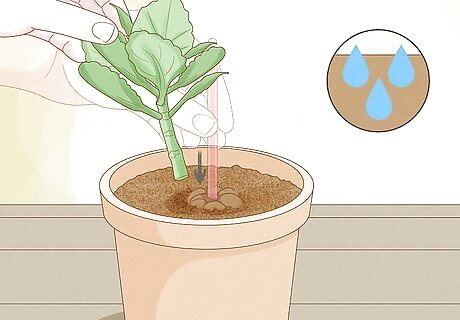
Place the cutting in the soil. Fill a small pot with drainage holes in the bottom with well-drained soil. Clay pots are a good choice for succulents because they breathe. Then make a hole in the soil with a pencil or pen. Take the dried cutting and place it in the hole you made, letting the top of the cutting poke out. It’s essential to get well-drained soil for your cutting so that the soil doesn’t trap too much moisture. You can find well-drained soil at gardening stores, and can even find soil that is formulated especially for succulents. You can also try a mix of 60% peat moss and 40% perlite. Only dunk the cutting once in rooting hormone. Using too much rooting hormone can have a negative effect on the growth of the plant.
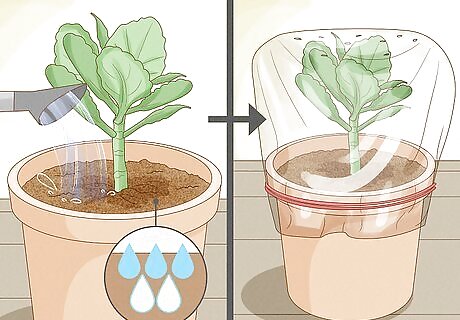
Wet the soil and cover the pot with a plastic bag. Once you stick the cutting into the soil, lightly water the soil until it is barely moist. Then take a large plastic bag, cut some slits in the top, and place it over the pot to completely cover it. Using the plastic bag to cover the pot helps make a humid environment for the cutting so that it flourishes and grows.
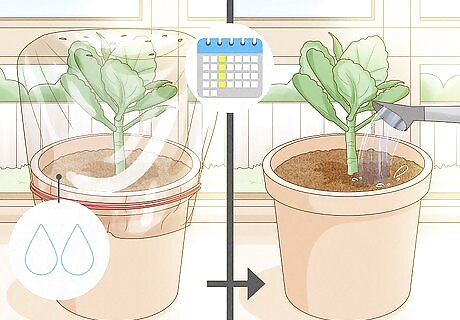
Place the pot in bright, indirect sunlight and water occasionally. After you place the bag over the pot, put the pot on a table or windowsill in indirect sunlight. Check the soil about once a week and water lightly if the soil is dry, replacing the bag back on top of the pot after watering. Until your kalanchoe has rooted, it needs to remain in bright, indirect sunlight.

Take the bag off the top after 2-3 weeks. After 2-3 weeks, the roots should start growing. At this point, you can take the bag off the top of the pot, still keeping the pot in a sunny place and watering about once a week when the soil is dry.
Caring for Kalanchoe Plants
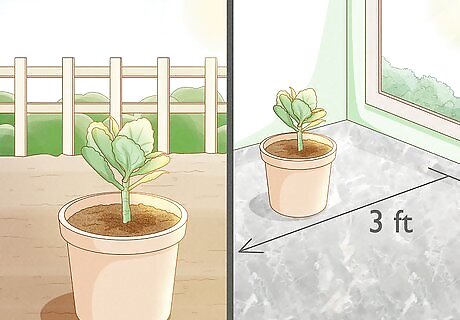
Give kalanchoe enough sunlight. Kalanchoe need plenty of sunlight, no matter if you are growing the plant from a cutting or have bought it fully grown. If you are growing the kalanchoe inside, place it in a south-facing window in winter for direct sunlight, and in an east or west window for bright indirect sunlight in the summer. During the summer, too much direct sunlight can harm your plant. If your kalanchoe is inside, place it within 3 ft (0.91 m) of a window so it will get enough light.
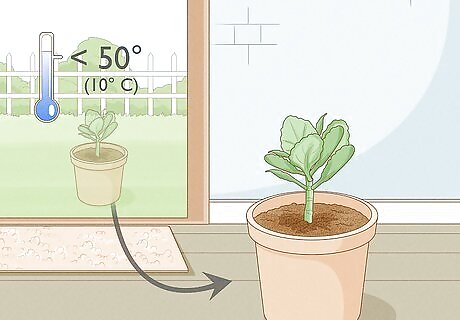
Keep kalanchoe in moderate to warm temperatures. Like most succulents, kalanchoe grow best in moderate to warm temperatures. Kalanchoe do well in typical household temperatures, but if you are growing kalanchoe outside in pots, take them in whenever the temperature drops below 50 degrees Fahrenheit (10 degrees C).
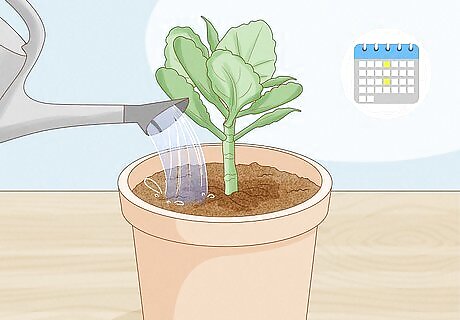
Water kalanchoe about every week and a half. Kalanchoe need a very specific amount of water so that they receive the proper nourishment but don’t suffer from overwatering. When the soil is dry, water the plant deeply until water comes out of the bottom holes of the pot and pools in the drainage tray. Remove the tray from the bottom and pour out the water, then place the tray back under the pot. Allow the soil to dry completely, about a week and a half, then water again. You can also water your plant by filling a tray with water, setting the pot in the water, and allowing the water to soak up until the soil is moist at the top. That ensures the roots will get saturated, but the actual leaves won't get wet.
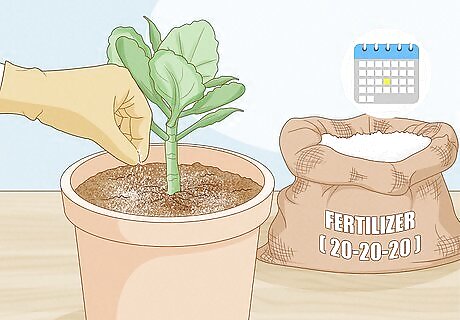
Fertilize your kalanchoe once a month. Though kalanchoe are relatively self-sufficient plants, they do benefit from occasional fertilizing. Use a balanced, organic fertilizer such as a 20-20-20. To apply the fertilizer, follow the instructions on the label, making sure not to apply more fertilizer than the label advises. If you buy your plant from a store, it should come fertilized and you shouldn’t have to worry about it for a couple of months or so.
Protecting and Pruning Your Kalanchoe Plant

Keep your plant out of the rain. If you are keeping your kalanchoe plant outside, make sure to put it in a well-protected area so that it isn’t exposed to rain. Rain can oversaturate the plant and even kill it.

Clip off dead flower stalks. Once your kalanchoe has bloomed, keep an eye out for dead stalks or foliage. If you any dead growths, clip them off carefully with a pair of sharp shears right below where the dead growth starts. Reduce the amount of watering you give the plant for a couple of weeks after cutting dead growths.
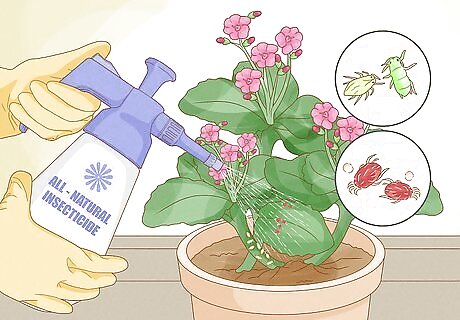
Use all-natural insecticide alternatives to combat bugs. Though kalanchoe are generally resistant to disease and most insects, if they are being raised outside they can be damaged by certain bugs such as aphids and spider mites. Combat insects by applying an organic insecticide spray according to the packaging. You can also make your own all natural insecticide by mixing a few drops of dish soap, a few drops of canola or sunflower oil, and a liter of water (33.8 ounces). To apply, spray the plant directly on the affected area where the bugs are attached to the plant.
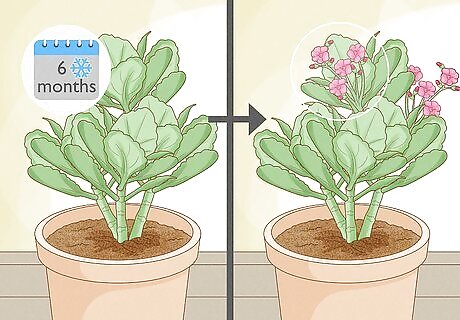
Get your kalanchoe to re-bloom. Kalanchoes can flower again the next season if you take the proper steps to care for them. Your plant will need at least six weeks of natural winter days in order for its flower buds to form, which means about 12 hours of darkness each day. Your plant needs to be in the dark when the sun is down during fall and winter. Since you will likely be keeping the plant inside to protect it from the cold, place it in a room that is dark or inside of a closet during the evening and nighttime hours. This will allow the plant to bud.

















Comments
0 comment